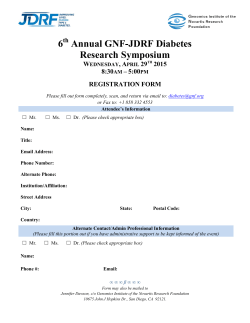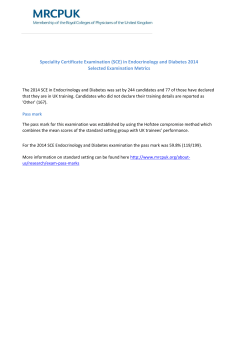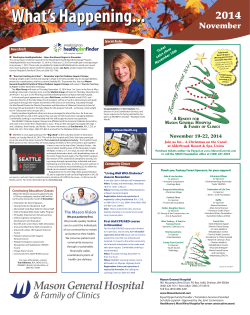
An Insurer-Based Diabetes Educator
BRIDGES TO EXCELLENCE An Insurer-Based Diabetes Educator– Community Partnership: Leveraging Education and Diabetes Support (LEADS) Linda M. Siminerio,1 Karen DePasquale,2 Patricia Johnson,3 and Margaret Thearle3 B University of Pittsburgh, Pittsburgh, PA 1 UPMC Health Plan, Pittsburgh, PA 2 University of Pittsburgh Diabetes Institute, Pittsburgh, PA 3 Corresponding author: Linda M. Siminerio, simineriol@upmc.edu DOI: 10.2337/diaclin.33.2.70 ©2015 by the American Diabetes Association. Readers may use this article as long as the work is properly cited, the use is educational and not for profit, and the work is not altered. See http:// creativecommons.org/licenses/by-nc-nd/3.0 for details. y the end of this decade, diabetes likely will affect 15% of Americans, or ~39 million people (1). This is particularly alarming given the nature of the disease and its complications. In addition to the humanistic burden, the economic consequences are substantial. The cost of medical care for patients with diabetes averages 2.3 times higher than for similar patients without diabetes, which translates to additional medical expenses of $6,649 per person with diabetes (2,3). Payers are particularly interested in exploring ways to reduce these costs. The annual cost of care for a person with diabetes in the commercially insured population has been reported to be between $8,000 and $12,000, excluding the costs of prescription drugs. Cost data from 2009 in a sample of 10 million commercial insurance plan members showed an average cost of members with diabetes to be ~$11,700 compared to an average $4,400 for the remainder of the population. The average yearly costs of $20,700 for people with complications of diabetes are almost three times higher than the average cost of $7,800 for those without complications (1). There is now a large evidence base about effective interventions that address the complexities of managing chronic disease. Health plans are expected to use these resources to provide services and preventive care and to explore new partnerships. Interventions shown to reduce the diabetes burden, including practice redesign, coaching, telephone-based support, hospital transitional care, and community programs are being instituted (4–8). The University of Pittsburgh Medical Center (UPMC) Health Plan is the insurance division for UPMC, an integrated health system, including hospital, community, and physician divisions. UPMC Health Plan offers a range of health insurance products and serves nearly 2.3 million members. UPMC Health Plan is exploring strategies to better meet the needs of its 78,000 members with diabetes. Diabetes educators are in a unique position to support disease management programs. Educators understand the challenges of diabetes and are a trusted resource for insurer-employed personnel who support care, health care providers, and the greater community. New venues and opportunities beyond traditional educator roles need to be explored given the current dynamics of health care. Project Description The aim of this project was to develop and describe an innovative role for certified diabetes educators (CDEs) in an insurer model. Formative evaluation is performed throughout implementation with the aim of improving the program’s design and performance. Leveraging Education and Diabetes Support Recognizing that health plan members with diabetes require compre- 70CLINICAL.DIABETESJOURNALS.ORG siminerio et al. ■ FIGURE 1. LEADS program CDEs serve as resources to diverse care management services. hensive management and services throughout the course of their disease, UPMC Health Plan established the Leveraging Education and Diabetes Support (LEADS) management model. The LEADS program employs two CDEs who serve as hub resources to a network of diverse care management services (Figure 1). CDEs are responsible for advising on the care of highrisk patients, providing training and support, and acting as community liaisons. The LEADS model provides the necessary support for members with diabetes and addresses the concerns of service line staff regarding their ability to adequately support diabetes patients given the complexity of diabetes management. Unlike other chronic diseases, diabetes requires staff to provide information on a variety of rapidly changing topics, including nutrition, blood glucose monitoring, medications, and risk reduction. Patient-Centered Medical Home The Patient-Centered Medical Home (PCMH) is a primary care model that is patient-centered, team-based, and focused on quality (9). Support for primary care is of interest to insurers because >90% of adults with diabetes receive their care from primary care providers (PCPs). To date, the UPMC Health Plan has implemented the PCMH model in 372 practices that include the services of 878 PCPs supported by 71 practice-based care managers (PBCMs) covering 17,688 patient members. PBCMs are expected to ensure that key elements of the PCMH, including population management, evidence-based practice, self-management support, and measures for quality improvement, are performed. The LEADS project CDEs provide training and direct support to PBCMs who identify patient members with complex problems or at high risk of developing them (e.g., those with poor glycemic control or frequent emergency room visits or hospitalizations). A CDE meets with a PCBM and the patient in question, guides the development of a care plan (with PCP approval), and offers ongoing assistance in operationalizing the plan. PCBMs also receive indirect support from the CDEs for less complicated patient problems via telephone consultations. Ongoing Support and Training People living with chronic disease need support services beyond what can be delivered in a primary care visit (10). The UPMC Health Plan offers ongoing telephone-based assistance to members through several programs. Health coaches support lifestyle interventions, encourage goal setting, develop action plans, and act as a resource for continued assistance. In an effort to provide a safe transition from hospital to home and prevent readmissions, the UPMC Health Plan also developed the Optimal Discharge Program. This program includes collaboration with hospital services organized by a transition care coordinator. Service line staff, coaches, and coordinators come from various disciplines and clinical experiences and often are unfamiliar with diabetes management. To orient these staff members to diabetes, the LEADS CDEs developed a series of training modules that offer diabetes-specific content, including nutrition, medications, glucose monitoring, physical activity, and distress. All service line staff members providing diabetes services are expected to participate in the CDE-led training sessions as a way to establish diabetes-specific competencies. Community Resource and Liaison LEADS CDEs are actively involved in the planning and implementation of community programs. For example, the UPMC Health Plan supports services to seniors within its membership who receive care through assistedliving and nursing-home facilities. The CDEs are available for diabetes initiatives deployed in community settings. For example, the CDEs organized training programs to train nursing-home staff in a system-wide conversion from insulin syringes to pen delivery devices. The CDEs also actively participate in specific programs that are driven by insurer mandates such as meeting Healthcare Effectiveness Data and Information Set (HEDIS) requirements. To provide access to services required by HEDIS (e.g., eye examinations), a mobile clinic van is deployed to specific communities with poor access. The CDEs provide thorough assessments, identify barriers, problem-solve, deliver education, and communicate the importance of routine exams for pre-identified members with diabe- V O L U M E 3 3 , N U M B E R 2 , S P R I N G 2 0 1 5 71 BRIDGES TO EXCELLENCE tes at mobile events. They arrange for ongoing follow-up through insurer and community resources, PCBMs, coaches, and local diabetes education programs to ensure the patients’ continued engagement and care. Project Results To evaluate the LEADS project on clinical outcomes, patients’ A1C values were monitored through the electronic medical record. Program processes were measured by having staff members complete questionnaires to determine their level of confidence after participating in CDE-led training sessions. The number of patient members who met with a CDE at mobile events was computed to determine reach. After 1 year of the LEADS project: • There was mean reduction in A1C from 9.2 to 8.8% in 79 patients identified for high-risk management services from the CDEs. PCBMs reported high satisfaction with CDE-provided training and support. • Eighty service line staff members, including PCBMs, coaches, and other coordinators participated in CDE-led training sessions. These staff members reported an increase in their confidence and overall ability to assist patients after training. • LEADS CDEs provided educational assessments and referrals for 215 members at mobile events. Discussion The LEADS project continues to evolve based on ongoing formative evaluation. The responsibilities of the CDEs continue to expand to all service lines (Figure 1). Plans to collect and analyze a host of clinical and claims data are underway. The LEADS project has been well received and sustained through the continued engagement of the CDEs. Disease management models such as the LEADS project, which positions skilled health educators as hub resources, may be effective strategies for health plans to provide high-quality, patient-centered, community-based care. Although further evaluation of patient outcomes, costs, and service utilization are warranted, insurers and diabetes educators may want to consider partnering in new delivery models such as the LEADS project. Acknowledgments unitedhealthgroup.com/reform. Accessed 11 September 2014 2. Centers for Disease Control and Prevention. National Diabetes Statistics Report: Estimates of Diabetes and Its Burden in the United States, 2014. Atlanta, GA, U.S. Department of Health and Human Services, 2014 3. American Diabetes Association. Economic costs of diabetes in the U.S. in 2007. Diabetes Care 2008;31:596–615 4. Rosenzweig J, Taitel MS, Norman GK, Moore TJ, Turenne W, Tang P. Diabetes disease management in Medicare Advantage reduces hospitalizations and costs. Am J Manag Care 2010;16:157–162 5. Davidson M, Blanco-Castellanos M, Duran P. Integrating nurse-directed diabetes management into a primary care setting. Am J Manag Care 2010;16:652–656 6. Siminerio L, Ruppert K, Gabbay R. Who best provides diabetes self-management support in primary care? Findings from a randomized controlled trial. Diabetes Educ 2013;39:705–713 7. Cranor CW, Bunting BA, Christensen DB. The Asheville Project: long-term clinical and economic outcomes of a community pharmacy diabetes care program. J Am Pharm Assoc 2003;43:173–184 The authors thank the UPMC Health Plan for its support and specifically acknowledge Jennifer Sholtes, RD, and Jodi Krall, PhD, for their efforts on the project. 8. New York State Department of Health. Quality strategy for the New York state Medicaid managed care program. Available from http://www.health.state.ny.us/health_ care/manage. Accessed 11 September 2014 Duality of Interest References 9. Gabbay R, Bailit M, Mauger D, Wagner E, Siminerio L. Multi-payer patient-centered medical home implementation guided by the chronic care model. Joint Comm J Qual Patient Saf 2011;37:265–273 1. United Health Center for Health Reform & Modernization. The United States of Diabetes: Challenges and Opportunities in the Decade Ahead. Available from www. 10. Spatz C, Bricker P, Gabbay R. The patient-centered medical neighborhood: transformation of specialty care. Am J Med Qual 2014;29:344–349 No potential conflicts of interest relevant to this article were reported. 72CLINICAL.DIABETESJOURNALS.ORG
© Copyright 2025









